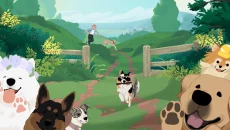Connector Contributor
“The Legend of Zelda” is known to many as Nintendo’s signature action adventure series. So it may be surprising that Nintendo has added cooperative multiplayer and more puzzles to the mix. On Oct. 23 “The Legend of Zelda: Tri Force Heroes” hit stores in North America. The game combines the monster slashing, rupee seeking adventure fans expect with a much greater emphasis on puzzles and problem solving.
The first thing that fans may notice is that the visuals greatly resemble those of “The Legend of Zelda: A Link Between Worlds.” The cartoon-like style returns almost unchanged with some enemy designs and various natural elements retaining their appearance. But this look pairs perfectly with the soundtrack. Like “A Link Between Worlds,” the music is mostly simple but varied. Players can expect the same satisfaction of hearing different twists on the game’s many tracks simply by changing their formation. The game can somehow flawlessly shift from the peaceful song of a level to the epic and upbeat thrill of a boss.
But visuals and music were not the only thing to be taken from Nintendo’s previous title. “Tri Force Heroes” has almost identical gameplay to “A Link Between Worlds.” The controls are exactly the same and the top-down camera angle is used once again. These controls worked then, and they definitely work now. The game is simple to play and it never seems as though the controls are overly complicated.
Where “Tri Force Heroes” begins to deviate is in its level design. Instead of the closed world setup of most “Legend of Zelda” games, a more structured approach is taken. Players simply go to a hub area and select a level to play rather than having to seek the spot out. Each level functions as a mini dungeon full of puzzles and tasks.
But the new features do not stop there. Now Link can change his appearance with a number of outfit changes. Ranging from Princess Zelda’s classic dress to a cactus suit, each outfit gives Link a new and unique ability. The player is tasked with gathering specific materials throughout the game in order to craft new outfits. That being said, creating most of the outfits is entirely optional but they do add a fun and new twist to the regular gameplay.
The biggest new addition, though, is that the player is now controlling three units, not just one. This means that three different versions of Link, green, blue and red each, must work together to complete each stage. On top of this, all three units share one health bar, meaning a mistake made with one Link will impact the other two. This is where there is a fork in the road for this game. The player has the option to fly solo and control all three by themselves or they can venture into the world of co-op play, available in both online and local varieties.
The multiplayer is quite straightforward in its design. Players are connected to two other users in their region, each of them is given control of one Link and they venture into the stage together. The major downside of this is communication. No text or voice based means of speaking with online partners is given. All the player has are eight picture icons that can be sent to teammates. For simple challenges, this works fine, but these do little when trying to solve anything complicated. The messages trying to be sent end up very cryptic and strange and are misinterpreted far too often. A throw icon, cheerleader icon, and disappointment icon do not exactly combine for a clear message for “throw me up on a ledge, now go press the button.” In all frankness, the multiplayer feels like it would be worlds less frustrating if all three players were in the room. Luckily, local multiplayer is available. A silver lining in this is the on screen update system used to inform the player when a partner finds something of value or is taking damage. This way the player can easily tell which teammate is the one messing up the most. But sometimes the stars align and three players who are synced well come together and really do a good job, but it is all luck up to there.
The single player option has its quirks as well. While switching between which Link is being controlled is quite smooth and easy, the problem comes with solving a few certain puzzles along the way. In a few spots it becomes clear that the levels are more geared toward multiple people being involved rather than just one. In these few cases the player’s reaction time needs to be swift, and luck needs to be on their side in order to get through. While this is aggravating, these portions are few and far between.
Overall, “The Legend of Zelda: Tri Force Heroes” is a big shift from what fans are used to. “Tri Force Heroes” certainly has its quirks that will make it memorable in a now extensive franchise. The game is fun, different and creative, and is a great game to play with friends.



